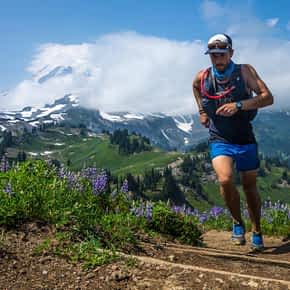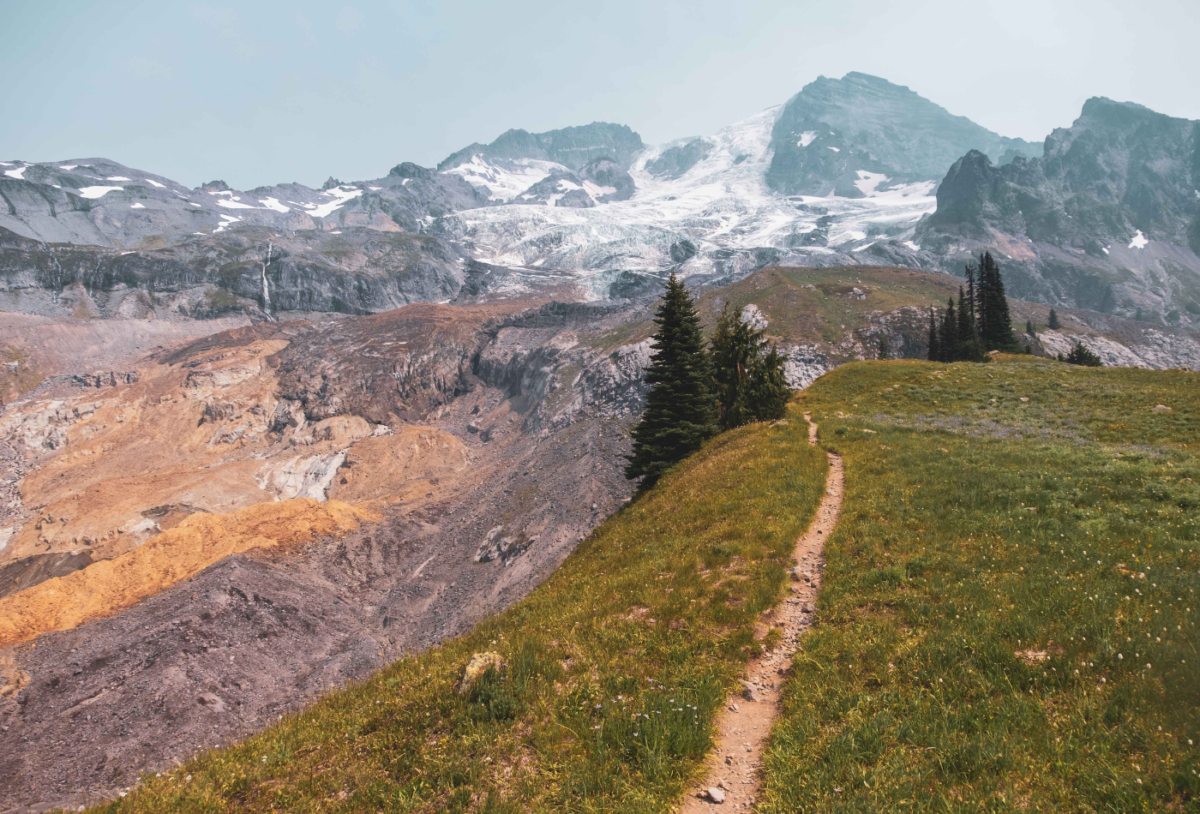
9,000: The estimated number of years Indigenous communities have been living in regions surrounding Mount Tahoma (settler name: Mount Rainier).
6: The number of regional tribes that experience Tahoma as kin: Puyallup, Nisqually, Cowlitz, Squaxin Island, Muckleshoot, and Yakama.
6: The different Indigenous naming variations of the mountain: Tahoma (“mother of waters” or “the place where the water begins”), Tacoma, Tacobeh, Pooskaus, Ti’Swaq. Tahol, “Mother of Waters. “Snowy Peak.” “The source of nourishment from the many streams coming from the slopes.” (There are more.) Myths surrounding the mountain include floods, Coyote running to the peak for refuge from encroaching gush of water (there are more).
1792: The spring during which Captain George Vancouver sailed into the Puget Sound and named the large mountain in the distance after his comrade, Peter Rainier, an “unremarkable eighteenth-century rear admiral” who fought in the Revolutionary War, fought actively to squash the revolution. This man would not be mistaken as a god.
0: The number of times Peter Rainier, colonizer namesake of Mount Rainier, ever stepped foot in the Pacific Northwest, ever saw Tahoma with his own eyes, ever cried at its majesty, ever dropped to his knees in trembling prayer, humbled by its glaciated heft. Ever. Never.
2 out of 100: The rating for Rainier Beer on RateBeer.com, a cheap, forgettable lager that, until recently, was brewed in Irwindale, California, still named Rainier, still named after a sorry red coat counterrevolutionary who, lest we repeat, never stepped foot in the Pacific Northwest.
0: The number of times Indigenous peoples are acknowledged in the “Origins” section of Irwindale, California’s city government website, a city that brewed for decades with stolen water this unexciting lager improperly named after a stolen mountain in the Pacific Northwest, a name of a counterrevolutionary who never even saw the mountain, never smelled the land, never met or listened to any of the many tribes living there, never knew the rich tapestry of human and nonhuman communities calling this mountain home, its surrounding bounty of land, air, and water, for thousands of years before his royalist birth.
1833: The year Dr. William Fraser Tolmie, a Scot working for the Hudson’s Bay Company, decided he’d travel inland to the base of Tahoma for a “botanist excursion,” which he did, making him the first European ever to reach the mountain’s base, successful only due to the deft guidance of two Indigenous huntsman, Lachalet (Nisqually) and Nuckalkat (Puyallup).
1870: The year of the first known summit of Rainier, August 17. Hazard Stevens and Philemon Beecher Van Trump. Sluiskin, a Yakama hunter living with the Upper Cowlitz, guided the men, thinking them fools for wanting to summit. Mountains are gods meant to be left alone, to be respected. Sluiskin was not happy with their intentions of conquest, as this peak housed a lake of fire at the top where a demonic spirit resided. He begged them not to scale the mountain, but the mountaineers continued, unabated, and conquer they did.
400+: The estimated number of bodies, hikers and climbers, held dead on Tahoma’s slopes since the first summit.
1899: The year, on March 2, when President McKinley established Mount Rainier National Park, America’s fifth park. (1: Yellowstone, 1872, STOLEN; 2: Sequoia, 1890, STOLEN; 3: Yosemite, 1890,
STOLEN; 4: Rock Creek, 1890, STOLEN).
1907: The year workers broke ground on the Wonderland Trail.

130-140: The number of miles planned when building the original Wonderland Trail.
1915: The year the Wonderland Trail was finished, just in time for the Mountaineers Annual meeting.
1917: The year the US government, through eminent domain, demanded Nisqually land for Fort Lewis, Washington, fifty miles west of Tahoma.

1920: Year the Wonderland Trail was officially branded by the park’s superintendent, mainly for marketing purposes to position Rainier as a tourist destination.
32: The number of Marines killed in 1946 when their plane crashed into the South Tahoma Glacier. They remain entombed to this day.
9: Number of shiny UFO objects witnessed by the pilot Kenneth Arnold zinging through the sky on June 24, 1947, the first of many extraterrestrial accounts that now surround the volcano.
2 million: Visitors to Mount Rainier Park annually.
10,000: Number of average Tahoma summit attempts.
50%: Percentage of successful summit attempts.
1.9%: Percentage, in 2019, of Washington (another colonizer naming convention) residents who identify as American Indian.
29: federally recognized tribes in Washington State.
1,122 inches: total snowfall on Mount Tahoma in 1972.
266 inches: total snowfall on Mount Tahoma in 2014.
105: degrees Fahrenheit recorded this June in Longmire, a record.

2015: The year Mount McKinley was returned to its traditional Koyukon Athabascan name, Denali.
0: The number you will find on East Rutherford, New Jersey’s city government website any mention of the Indigenous Munsee Lenape, who originally inhabited this area of New Jersey now colonized and established in 1894 as East Rutherford, about the same time Mount Rainier became a national park, 2,885 miles west.
43 – 8: The final score of the 2014 Super Bowl, held at the Metlife Stadium in East Rutherford, New Jersey, between the Seattle Seahawks and the Denver Broncos, the year the Washington State Senate temporarily changed the colonizer name of Mount Rainier not to one of several Indigenous names of the volcano, but to this:
Mount Seattle Seahawks.

Nicholas Triolo is a writer, long-distance runner, and Wonderland guide for Aspire (2016-2018). He holds a master’s of science in environmental studies from the University of Montana, where he was senior editor for Camas Magazine. Triolo currently works as Digital Strategist for Orion Magazine, and is based in western Massachusetts. He is former associate director for the Todos Santos Writing Workshop and co-facilitator for the Freeflow Wilderness Writing Institute. His writing, films, and photography have been featured in Orion, Terrain.org, Best American Poetry Blog, Juxtaprose, Trail Runner Magazine, Patagonia’s Dirtbag Diaries, and others. More at: nicholastriolo.net

